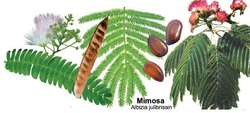In a recent market survey, it was noticed that Global
Mimosa Oil market size will increase to Million US$ by 2025, from Million US$ in 2018.
Over the 6 yr study, 7 plant-feeding stink bug species were detected on
mimosa. Chinavia hilaris was the predominant stink bug species (63.5%) ([chi square] = 1617.7; df = 5; P < 0.001) followed by N.
"
Mimosa reopened, and I wish to thank the judiciary ...
Although the
mimosa appears in Darwin's The Botanic Garden (1791), it was Bose who for the first time sought to make the touch-sensitive plant "speak", along with Codariocalyx motorius (the Indian Telegraph Plant), a plant that performed apparently spontaneous movement.
Mimosa Networks is the global technology provider of wireless broadband solutions, delivering fiber-fast connectivity to service providers and enterprise, industrial and government operators worldwide.
Mimosa Networks is the global technology specialist in wireless broadband solutions, delivering fibre-fast connectivity to service providers and enterprise, industrial and government operators worldwide.
Se seleccionaron 24 taxa de
Mimosa presentes en Mexico, los cuales presentaron forma de vida arborea (un solo tronco lenoso, con ramificacion a partir del metro de altura) o arbustiva (al menos dos troncos lenosos, con ramificacion desde la base); dichos taxa pertenecen a diferentes secciones y series del genero (Cuadro 1).
Algunos trabajos que han hecho aportaciones en el estudio de la interaccion entre Bruchidae y
Mimosa son: Bottimer (1969) en su publicacion corrige datos erroneos de bruquidos en semillas de
Mimosa, describe nuevas especies y aumento el numero de hospederos para otras; Johnson (1983, 1990) en sus trabajos de sistematica del genero Acanthoscelides, enlista las especies del sur de Mexico, Centroamerica y el norte de Sudamerica, donde se describieron un gran numero especies que se asocian a
Mimosa; Kingsolver (2004) enlista y describe algunas especies asociadas a
Mimosa en su manual de Bruchidae para Estados Unidos y Canada, asi como algunos datos ecologicos; algunos trabajos como Harley et al.
Leaves, branches and roots of
Mimosa verrucosa Benth.
It took 60 days for the
Mimosa to arrive in Patagonia, a voyage which included four deaths and two child births.
